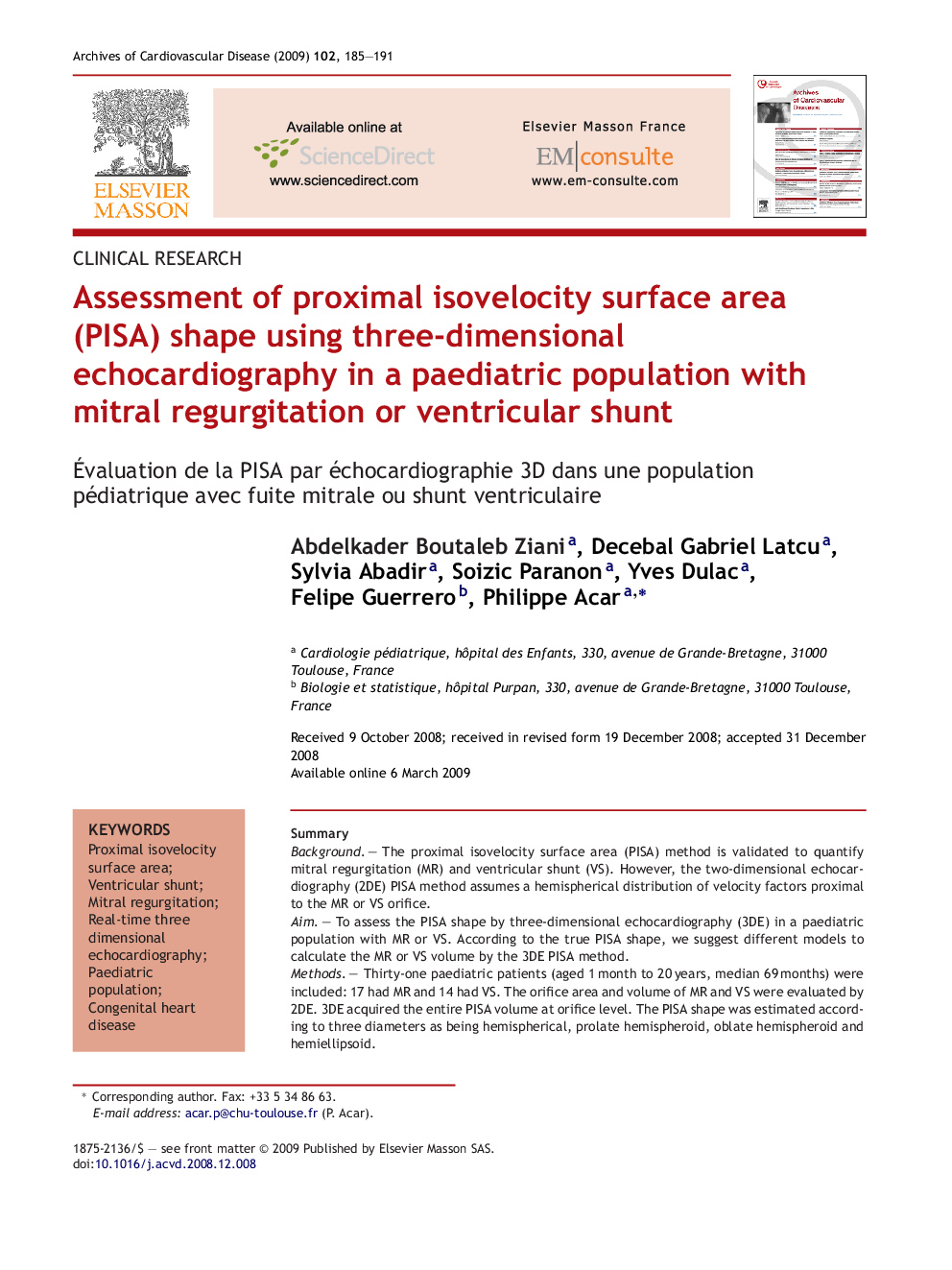| کد مقاله | کد نشریه | سال انتشار | مقاله انگلیسی | نسخه تمام متن |
|---|---|---|---|---|
| 2889254 | 1574406 | 2009 | 7 صفحه PDF | دانلود رایگان |

SummaryBackgroundThe proximal isovelocity surface area (PISA) method is validated to quantify mitral regurgitation (MR) and ventricular shunt (VS). However, the two-dimensional echocardiography (2DE) PISA method assumes a hemispherical distribution of velocity factors proximal to the MR or VS orifice.AimTo assess the PISA shape by three-dimensional echocardiography (3DE) in a paediatric population with MR or VS. According to the true PISA shape, we suggest different models to calculate the MR or VS volume by the 3DE PISA method.MethodsThirty-one paediatric patients (aged 1 month to 20 years, median 69 months) were included: 17 had MR and 14 had VS. The orifice area and volume of MR and VS were evaluated by 2DE. 3DE acquired the entire PISA volume at orifice level. The PISA shape was estimated according to three diameters as being hemispherical, prolate hemispheroid, oblate hemispheroid and hemiellipsoid.ResultsData from 28 patients were analysed. The PISA shape was variable: hemispherical, 11%; prolate hemispheroid, 43%; oblate hemispheroid, 32%; hemiellipsoid, 14%. Oblate hemispheroids occurred more frequently in the MR group (47%), whereas prolate hemispheroids occurred more frequently in the VS group (62%); hemispheres were scarce in both groups (10%). The mean MR or VS orifices and volumes measured by 2DE and 3DE were significantly different (0.123 cm2 versus 0.094 cm2 and 13.2 mL versus 10.1 mL, respectively; p = 0.019).Conclusions3DE describes the true surface of the PISA shape. In a paediatric population with MR or VS, the PISA is rarely hemispherical but is more often prolate or oblate hemispheroid.
RésuméIntroductionLa PISA est une méthode validée pour quantifier les fuites mitrales (IM) et les shunts ventriculaires (SV). Néanmoins, cette méthode assume une géométrie hémisphérique de la PISA.ButLe but de notre étude a été d’étudier par échocardiographie 3D la géométrie réelle de la PISA.MéthodesTrente et un enfants (âge médian de 69 mois allant d’un mois à 20 ans) ont été inclus : 17 avaient une IM et 14 un SV. La surface de l’orifice et le volume régurgité ont été calculés par mesure de la PISA par méthode 2D et 3D. La faisabilité de la mesure 3D a été de 90 %.RésultatLa géométrie de la PISA était variable : hémisphérique (11 %), hémisphéroïde prolate (43 %), hémisphéroïde oblate (32 %) et hémilellipsoïde (14 %). Dans le groupe avec IM, la forme était de façon prépondérante hémisphéroïde oblate (47 %). Dans le groupe avec SV, la forme était plus souvent hémisphéroïde prolate (62 %). La surface moyenne de l’orifice de l’IM ou du SV était différente par les méthodes 2D et 3D (0,123 cm2 et 0,094 cm2, p = 0,019).ConclusionL’échocardiographie 3D est une nouvelle méthode permettant une approche plus réelle de la géométrie de la PISA.
Journal: Archives of Cardiovascular Diseases - Volume 102, Issue 3, March 2009, Pages 185–191